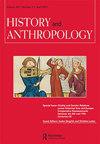Little Mecca in Canton: representations and resurgences of the graveyard of Sa’d ibn Abī Waqqās
IF 0.4
2区 历史学
Q3 ANTHROPOLOGY
引用次数: 1
Abstract
ABSTRACT The tomb of Sa'd ibn Abī Waqqās, a Companion of the Prophet Muhammad mythologized to have as having been buried in Canton, has attracted pilgrims from across China and beyond for the past three centuries. The repertoire on Abī Waqqās, an arriver from Mecca buried in Canton, is intriguing less for its factual veracity than the its manifold afterlives of the personage. This paper expands the scope of existing scholarship on Islam in China by directing attention to the previously unexamined textual corpus – stele inscriptions, imperial geographic surveys, mosque records, print periodicals, and recent unofficial historical surveys that date between from the fourteenth century and to the present. Transported between different mediums, Abī Waqqās as an ancestral figure has provided a powerful regenerative force for Chinese Muslims' historical consciousness that unfolds through a circular rather than linear time, and incorporates distant geographies without physical mobility. Moving beyond the textual realm, repetitions of the narrative materialized into a cemetery – a focal point that has mediated long-distance travels and donation networks; absorbed hybrid religious rituals ranging from ancestor worship grave rituals to dhikr practices; and capitalized on the Chinese state’s rhetoric of silk roads diplomacy. By unearthing rediscoveries of a symbolic figure through tides of time, the article shows how a supposedly unscientific myth narrativized conceptions of dual homes, here and elsewhere, and further established a regional Islamic hub, or a “little Mecca” in coastal China.广州的小麦加:赛义德·伊本·阿布伊坟场的再现与复兴Waqqās
本文章由计算机程序翻译,如有差异,请以英文原文为准。
求助全文
约1分钟内获得全文
求助全文
来源期刊

History and Anthropology
Multiple-
CiteScore
1.80
自引率
0.00%
发文量
41
期刊介绍:
History and Anthropology continues to address the intersection of history and social sciences, focusing on the interchange between anthropologically-informed history, historically-informed anthropology and the history of ethnographic and anthropological representation. It is now widely perceived that the formerly dominant ahistorical perspectives within anthropology severely restricted interpretation and analysis. Much recent work has therefore been concerned with social change and colonial history and the traditional problems such as symbolism, have been rethought in historical terms. History and Anthropology publishes articles which develop these concerns, and is particularly interested in linking new substantive analyses with critical perspectives on anthropological discourse.
 求助内容:
求助内容: 应助结果提醒方式:
应助结果提醒方式:


